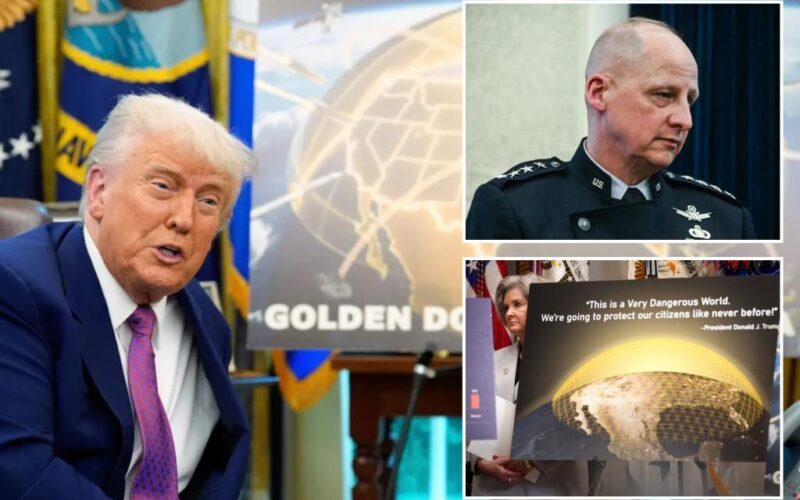WASHINGTON — President Trump on Tuesday named Space Force Gen. Michael Guetlein to lead his “Golden Dome” project to improve and integrate America’s missile defense technology — as House Republicans included $25 billion for the plan in the latest version of the “One Big Beautiful Bill Act.”
Trump said the plan would make good on Ronald Reagan’s “Star Wars” project in the 1980s to protect America from incoming nuclear missiles.
“We will truly be completing the job that President Reagan started 40 years ago, forever ending the missile threat to the American homeland,” Trump said in the Oval Office.
“The success rate is very close to 100%, which is incredible when you think of it, you’re shooting bullets out of the air,” he said, apparently referring to THAAD missile tests, which have been successful in shooting down intermediate-range ballistic missiles, rather than nuclear-equipped intercontinental ballistic missiles (ICBMs) from countries such as Russia, China and North Korea.
“Canada has called us, and they want to be a part of it. So we’ll be talking to them. They want to have protection also. So as usual, we help Canada,” Trump said, joined by Defense Secretary Pete Hegseth and Guetlein.
The president said that the new project would be done “in about three years” by the time he leaves office.
The “Golden Dome” name is taken from Israel’s US-funded “Iron Dome” system that has a high success rate in shooting down short-range missiles from neighboring terrorist groups.
“Once fully constructed, the Golden Dome will be capable of intercepting missiles even if they are launched from other sides of the world, and even if they’re launched from space. And we will have the best system ever,” Trump vowed.
“We helped Israel with theirs, and it was very successful, and now we have technology that’s even far advanced from that … hypersonic missiles, ballistic missiles and advanced cruise missiles, all of them will be knocked out of the air.”
Hegseth praised the program.
“President Reagan 40 years ago cast the vision for it. The technology wasn’t there now it is, and you’re following through, saying we will protect the homeland from cruise missiles, ballistic missiles, hypersonic missiles, drones, whether they’re conventional or nuclear.”
The pending legislation, whose major provisions include Trump’s campaign pledges to cut taxes on tips, overtime and Social Security benefits, allocates various funding pools for the project.
The bill includes $7.2 billion for “the development, procurement, and integration of military space-based sensors,” $5.6 billion for “development of space-based and boost phase intercept capabilities,” and $2.4 billion for “the development of military non-kinetic missile defense effects.”
Other funding in the pending bill includes $2.2 billion for “acceleration of hypersonic defense systems” and $2 billion for “air moving target indicator military satellites” and $1.97 billion for “improved ground-based missile defense radars.”
The Golden Dome plan offers a potential financial windfall to high-tech US defense contractors and Sens. Jim Banks (R-Ind.), Dan Sullivan (R-Alaska) and Kevin Cramer (R-ND) joined the Oval Office event to tout the potential beneficial effects on industry in their states.
US missile defense technology has advanced over the years, but testing has been infrequent and often unsuccessful.
The Ground-based Midcourse Defense (GMD) system, the current main US anti-ICBM defense technology, had an intercept success rate of just 57% from 1997 through December 2023, according to the Missile Defense Advocacy Alliance.
The three most recent intercept tests — in 2023, 2019 and 2017 — were successful, though real-world scenarios could reduce the system’s efficacy and the government says it would be overwhelmed by a full-scale nuclear war with Russia or China.
The Pentagon’s 2022 Missile Defense Review said: “GMD is neither intended for, nor capable of, defeating the large and sophisticated ICMB, air-, or sea-launched ballistic missile threats from Russia and [China]. The United States relies on strategic deterrence to address those threats.”
As of 2020, the US government spent $53 billion on the GMD system, with another $10 billion expected through 2025, according to the US Government Accountability Office.
Other emerging technologies have shown promise against ICMBs, which threaten to lay waste to America in the event of a nuclear war.
The Pentagon in 2020 announced that a test of the Standard Missile-3 (SM-3) Block IIA missile was successful in shooting down an ICBM.








